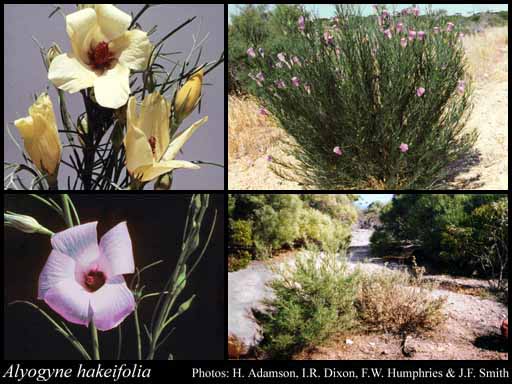- Reference
- Oesterr.Bot.Z. 13:12 (1863)
- Conservation Code
- Not threatened
- Naturalised Status
- Native to Western Australia
- Name Status
- Current
Erect, slender or spreading shrub, 1-3 m high. Fl. blue-purple/purple/cream-yellow, May or Aug to Dec or Jan to Feb. Red sandy soils, rocky loam, limestone. Undulating plains.







Scientific Description
Shrub, with glabrous stems. Leaves 65-125 mm long, 0.8-2 mm wide, not lobed or tripartitely lobed, simply (once-)lobed; margins entire; hairs and scales absent (leaves quite glabrous)with scales absent, Sessile glands absent; stipules present but early deciduous (only visible on youngest leaves). Perianth clearly of two whorls (calyx and corolla), the corolla obvious and prominent. Pedicel present, 15-25 mm long; glabrous, with scales absent. Epicalyx (extra segments or 'bracteoles' immediately below the calyx) present, 25-32 mm long, the lobes free, glabrous, Sessile glands absent. Calyx green, 25-27 mm long, the lobes fused half or more of their length, Sessile glands absent, scales absent, Terminal appendages absent, number of ribs absent. Corolla yellow, blue, purple or cream, 45-62 mm long, glabrous. Indumentum (outside) Sessile glands absent. Stamens many, united and arising from a staminal tube around the style; filaments present, 1.5-2 mm long; anthers 0.8-1.2 mm long, indumentum absent (anthers glabrous). Staminodes absent, appendages absent. Ovary hairs and scales absent (ovary quite glabrous); style 1, 26-30 mm long, with five style branches or lobes, mostly glabrous, wing absent. Fruits dehiscent (capsules and follicles), length-width ratio more or less as long as wide, hairs or scales present, simple hairs (without tubercle bases) present, stellate hairs present, Sessile glands absent, tubercle-based simple hairs absent, gland-tipped hairs absent, scales absent; apex rounded; prickles absent (except perhaps a terminal awn); terminal awns or spines absent; calyx persistent to mature fruit, not accrescent; carpels 4-5; seeds per loculus ≥5. Flowering time January, February, May, August, September, October, November or December. Distribution Botanical Province Eremaean or South-West, IBRA Bioregion Yalgoo, Coolgardie, Geraldton Sandplains, Swan Coastal Plain, Avon Wheatbelt, Jarrah Forest, Mallee and Esperance.
Distribution
- IBRA Regions
- Avon Wheatbelt, Coolgardie, Esperance Plains, Geraldton Sandplains, Hampton, Jarrah Forest, Mallee, Swan Coastal Plain, Yalgoo.
- IBRA Subregions
- Eastern Goldfield, Eastern Mallee, Edel, Fitzgerald, Geraldton Hills, Hampton, Katanning, Lesueur Sandplain, Mardabilla, Merredin, Northern Jarrah Forest, Perth, Recherche, Southern Cross, Tallering, Western Mallee.
- IMCRA Regions
- Central West Coast.
- Local Government Areas (LGAs)
- Beverley, Carnamah, Chapman Valley, Coolgardie, Coorow, Corrigin, Cunderdin, Dalwallinu, Dandaragan, Dundas, Esperance, Gingin, Gnowangerup, Goomalling, Greater Geraldton, Irwin, Kalgoorlie-Boulder, Kellerberrin, Kondinin, Kulin, Lake Grace, Merredin, Mingenew, Moora, Morawa, Mount Marshall, Narrogin, Northam, Northampton, Perenjori, Ravensthorpe, Shark Bay, Tammin, Victoria Plains, Waroona, Westonia, Wickepin, Wongan-Ballidu, Wyalkatchem, Yalgoo, Yilgarn.